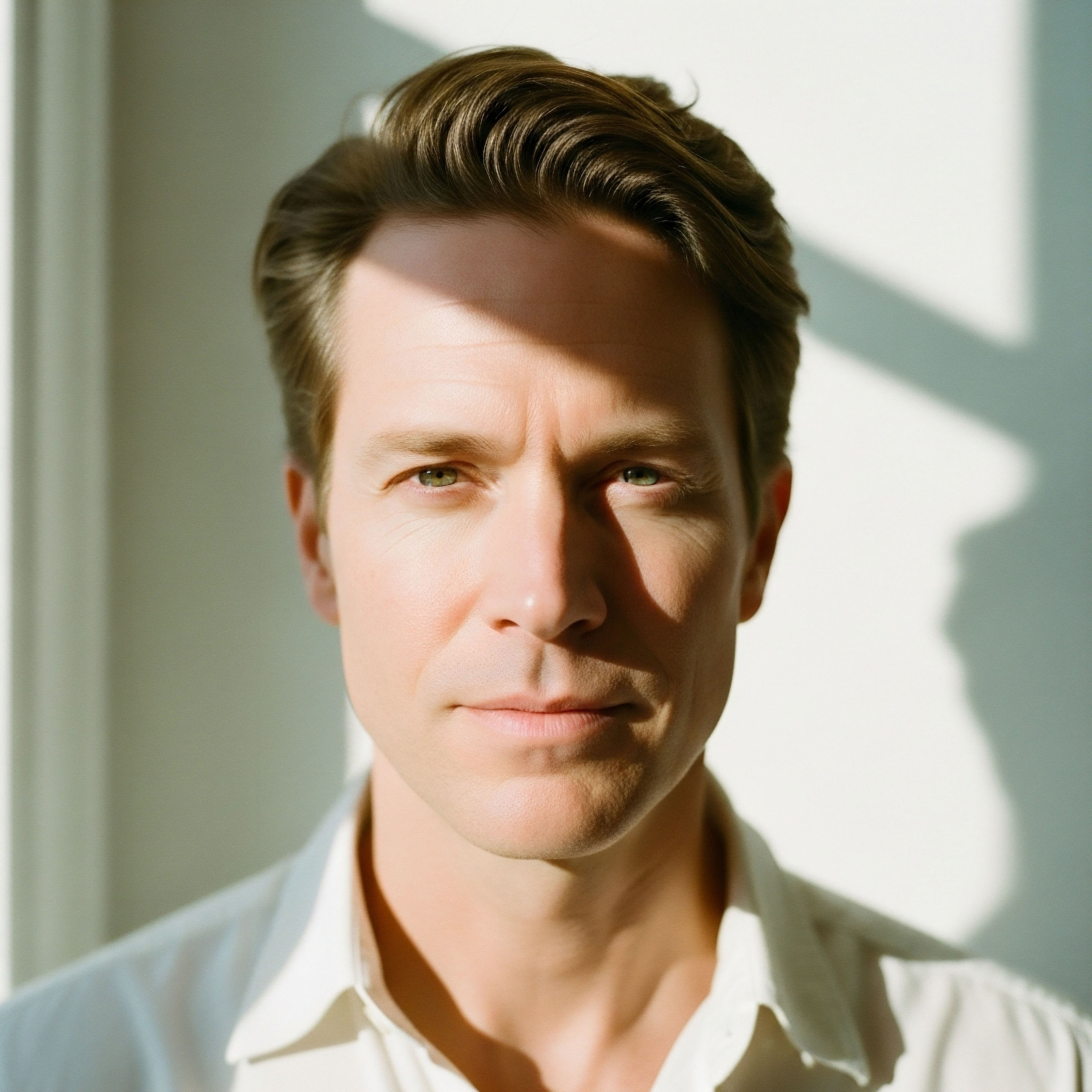

Fundamentals
Beginning a hormonal optimization protocol is a significant step in taking command of your biological narrative. It is entirely logical that questions about long-term safety, particularly concerning the prostate, are at the forefront of your mind. You may have encountered the long-standing belief that testosterone directly fuels prostate conditions, a concept that has created a great deal of apprehension.
This perspective stems from foundational mid-20th-century research that observed the effects of androgen deprivation. This created a simplified, linear model of risk that has persisted for decades. Today, our understanding of the endocrine system allows for a more detailed and accurate view of this intricate relationship.
The prostate gland’s health is indeed linked to androgens, the family of hormones that includes testosterone. These hormones are chemical messengers that interact with specific docking sites, known as androgen receptors, on prostate cells. This interaction is a normal physiological process that governs the gland’s development and function.
The central concern has been whether elevating testosterone levels through hormonal optimization could excessively stimulate these cells, potentially initiating or accelerating disease. This is a valid and important question that deserves a clear, evidence-based exploration, moving beyond historical assumptions to the clinical realities observed today.
Modern evidence provides a more sophisticated understanding of the interaction between testosterone and prostate health, moving beyond outdated, simplistic models of risk.
It is helpful to view testosterone’s role through the lens of a sophisticated signaling system. The hormone itself is a key, and the androgen receptors are the locks. The biological response depends on how these keys fit into the locks and the subsequent chain of events they initiate within the cell.
The health of the entire system is what dictates outcomes. Therefore, the conversation around long-term prostate health on a Testosterone Replacement Therapy (TRT) protocol is one of careful monitoring, personalized adjustment, and a deep appreciation for the body’s complex internal communication network. It involves understanding your unique baseline and tracking specific biomarkers over time to ensure the protocol is supporting your vitality without compromising prostate safety.


Intermediate
When implementing a hormonal optimization protocol, the long-term health of the prostate is a primary consideration, managed through a structured and proactive monitoring strategy. The historical apprehension surrounding TRT and prostate health has been substantially re-evaluated in light of extensive clinical data.
Modern protocols are built on the principle of maintaining testosterone levels within a therapeutic range while vigilantly tracking key prostate-related biomarkers. This ensures that the benefits of hormonal recalibration are achieved with a clear and objective understanding of their effects on the prostate gland.

Monitoring Protocols during TRT
A carefully managed TRT program involves regular laboratory testing to ensure both efficacy and safety. The cornerstone of prostate monitoring is the Prostate-Specific Antigen (PSA) test. PSA is a protein produced by both normal and malignant cells of the prostate gland.
While an elevated PSA can be an indicator of prostate cancer, it is also affected by other conditions such as Benign Prostatic Hyperplasia (BPH) and prostatitis. On TRT, it is common to see a slight increase in PSA levels, especially in the first year of treatment.
This rise typically stabilizes within a clinically acceptable range. The Endocrine Society clinical practice guidelines recommend assessing prostate cancer risk before starting therapy and monitoring PSA levels at 3 to 12 months after initiation. After the first year, monitoring aligns with standard age- and risk-appropriate screening guidelines.

Benign Prostatic Hyperplasia and Lower Urinary Tract Symptoms
Another area of focus is the effect of TRT on BPH, a non-cancerous enlargement of the prostate that can cause Lower Urinary Tract Symptoms (LUTS), such as increased urinary frequency or a weak stream. The concern has been that increasing testosterone levels might worsen these symptoms by stimulating further prostate growth.
Clinical evidence, however, does not consistently support this. Many studies, including randomized controlled trials, have shown that TRT does not significantly worsen LUTS for most men and, in some cases, may even improve them. The large-scale TRAVERSE trial, a study designed to assess cardiovascular safety, also tracked prostate outcomes and found no significant difference in the progression of urinary symptoms between the testosterone and placebo groups over an average follow-up of 33 months.
Systematic monitoring of PSA levels and urinary symptoms forms the basis of ensuring long-term prostate safety during testosterone therapy.
The table below outlines a typical monitoring schedule for a patient on a TRT protocol, emphasizing the key parameters for prostate health.
| Time Point | Key Assessments | Purpose |
|---|---|---|
| Baseline (Pre-TRT) | Total & Free Testosterone, PSA, Hematocrit, Digital Rectal Exam (DRE) | To establish initial hormonal status and assess pre-existing prostate conditions. |
| 3-6 Months | Total Testosterone, PSA, Hematocrit | To assess initial response to therapy and monitor for any significant changes in prostate biomarkers. |
| 12 Months | Total Testosterone, PSA, Hematocrit, DRE | To evaluate the steady-state response and confirm stabilization of PSA levels. |
| Annually Thereafter | Total Testosterone, PSA, Hematocrit, DRE | To conduct ongoing, long-term safety monitoring consistent with standard preventative health guidelines. |
This structured approach allows for the personalization of therapy. Anastrozole is often included in protocols to manage the conversion of testosterone to estrogen, which also plays a role in prostate physiology. Similarly, agents like Gonadorelin help maintain testicular function, contributing to a more balanced endocrine environment. By integrating these components and adhering to a rigorous monitoring schedule, it is possible to pursue the benefits of hormonal optimization while upholding a high standard of prostate safety.


Academic
The relationship between serum testosterone concentration and prostate cellular activity is a cornerstone of endocrine science. For many years, the prevailing paradigm was a simple dose-response model, suggesting a direct, linear correlation between androgen levels and prostate growth, both benign and malignant.
This concept, however, has been superseded by a more sophisticated and evidence-based framework ∞ the Androgen Receptor Saturation Model. This model provides a vital biochemical explanation for the clinical observation that testosterone administration in non-castrate men has a minimal impact on prostate cancer risk or progression.

The Androgen Receptor Saturation Model Explained
The Saturation Model is predicated on the finite number of androgen receptors (AR) within prostate tissue. Testosterone exerts its influence by binding to these receptors. The key insight of the model is that maximal androgen-AR binding, and therefore maximal stimulation of prostate cell activity, is achieved at relatively low serum testosterone concentrations.
Studies suggest this saturation point occurs at testosterone levels around 250 ng/dL. Below this threshold, the prostate is highly sensitive to changes in androgen levels. This explains the profound effect of androgen deprivation therapy (castration), which dramatically reduces testosterone and curtails prostate cancer growth. Above this saturation point, however, the androgen receptors are fully occupied.
Additional testosterone in the bloodstream has little to no further effect on prostate cell stimulation because there are no available receptors to bind to. This creates a plateau effect. For a man on a TRT protocol, whose testosterone levels are typically raised from a hypogonadal state to the mid-to-high normal range (e.g. 500-800 ng/dL), his levels are operating well above the saturation point. Therefore, fluctuations within this eugonadal range do not translate into increased prostate stimulation.
The Androgen Receptor Saturation Model explains why restoring testosterone to normal levels does not progressively increase prostate stimulation, as the receptors become fully saturated at a low threshold.

What Are the Clinical Implications for Prostate Cancer Risk?
The saturation model fundamentally reframes the discussion about TRT and prostate cancer. A large body of evidence, including multiple meta-analyses of randomized controlled trials, has failed to show a statistically significant increase in the incidence of prostate cancer among men receiving TRT compared to placebo.
The TRAVERSE trial, a landmark study involving over 5,200 men, found that the incidence of prostate cancer was less than 1% and was not significantly different between the testosterone and placebo groups during the study period. Some research even suggests that chronically low testosterone may be associated with a higher risk of more aggressive forms of prostate cancer, although this area requires further investigation.

Understanding Prostate Cancer Biology
It is also important to differentiate between the initiation of cancer and the behavior of established, high-grade disease. The development of prostate cancer is a complex, multi-factorial process. While androgens are permissive for the growth of normal prostate tissue, they are not believed to be the primary oncogenic driver. The table below contrasts the outdated linear model with the current saturation model.
| Concept | Outdated Linear Model | Androgen Receptor Saturation Model |
|---|---|---|
| Core Assumption | More testosterone always equals more prostate growth. | Prostate growth stimulation plateaus once androgen receptors are saturated. |
| Predicted TRT Effect | Should significantly increase BPH and prostate cancer risk. | Should have minimal to no effect on prostate growth in non-castrate men. |
| Clinical Evidence | Contradicted by modern clinical trials and meta-analyses. | Supported by extensive clinical data showing no increased risk of prostate cancer or BPH progression with TRT. |
This advanced understanding of androgen physiology and prostate biology provides a strong foundation for the safe, long-term administration of TRT. The focus of clinical management is on careful patient selection, adherence to established monitoring protocols, and a clear-eyed assessment of the robust scientific evidence, which indicates that restoring testosterone to physiological levels is not associated with an increased risk of developing prostate cancer.

References
- Bhasin, Shalender, et al. “Testosterone Therapy in Men with Hypogonadism ∞ An Endocrine Society Clinical Practice Guideline.” The Journal of Clinical Endocrinology & Metabolism, vol. 103, no. 5, 2018, pp. 1715-1744.
- Bhasin, Shalender, et al. “Prostate Safety Events During Testosterone Replacement Therapy in Men With Hypogonadism ∞ A Randomized, Placebo-Controlled Trial.” JAMA Network Open, vol. 6, no. 12, 2023, e2348579.
- Morgentaler, Abraham, and Abdulmaged M. Traish. “Shifting the Paradigm of Testosterone and Prostate Cancer ∞ The Saturation Model and the Limits of Androgen-Dependent Growth.” European Urology, vol. 55, no. 2, 2009, pp. 310-320.
- Khera, Mohit. “Testosterone Replacement Therapy and Prostate Cancer Incidence.” The World Journal of Men’s Health, vol. 39, no. 3, 2021, pp. 449-456.
- Baas, Wesley, and Tobias S. Kohler. “Testosterone Replacement Therapy and Voiding Dysfunction.” Translational Andrology and Urology, vol. 5, no. 4, 2016, pp. 585-592.
- Cui, Yanjun, and Heng Zuo. “The Effect of Testosterone Replacement Therapy on Prostate Cancer ∞ A Systematic Review and Meta-Analysis.” Prostate Cancer and Prostatic Diseases, vol. 17, no. 2, 2014, pp. 132-143.
- Fernandez-Balsells, M. M. et al. “Adverse Effects of Testosterone Therapy in Adult Men ∞ A Systematic Review and Meta-Analysis.” The Journal of Clinical Endocrinology & Metabolism, vol. 95, no. 6, 2010, pp. 2560-2575.
- Loeb, Stacy, et al. “Testosterone Replacement Therapy and Risk of Favorable and Aggressive Prostate Cancer.” Journal of Clinical Oncology, vol. 35, no. 13, 2017, pp. 1430-1436.

Reflection
You have now explored the scientific evolution in our understanding of testosterone and its relationship with the prostate. This knowledge moves the conversation from a place of apprehension to one of proactive management. The information presented here is a map, detailing the biological terrain and the clinical signposts used to navigate it safely.
Your personal health journey is unique, and this framework serves as a powerful tool for informed dialogue with your clinical team. The path forward is one of partnership, where objective data and your subjective experience work together to calibrate a protocol that supports your long-term vitality and well-being.



